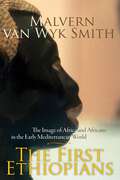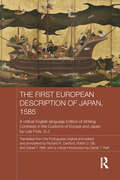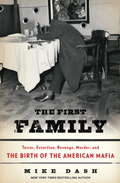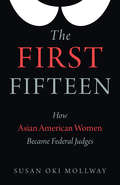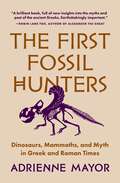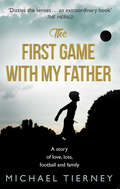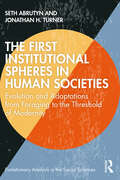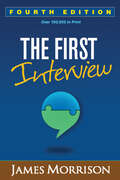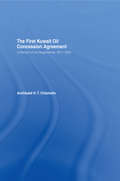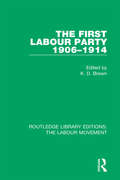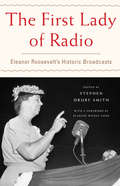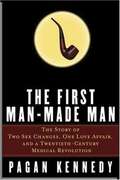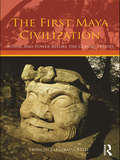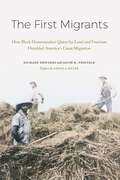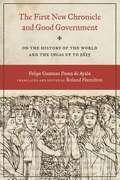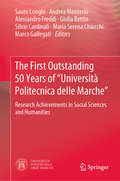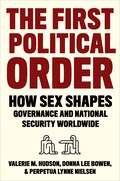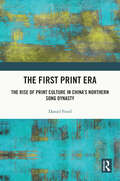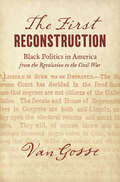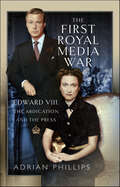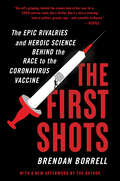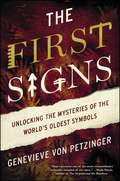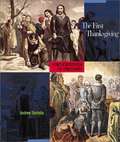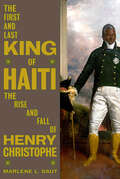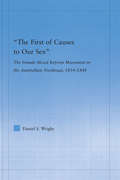- Table View
- List View
The First Ethiopians: The image of Africa and Africans in the early Mediterranean world
by Malvern van SmithThe First Ethiopians explores the images of Africa and Africans that evolved in ancient Egypt, in classical Greece and imperial Rome, in the early Mediterranean world, and in the early domains of Christianity. Inspired by curiosity regarding the origins of racism in southern Africa, Malvern van Wyk Smith consulted a wide range of sources: from rock art to classical travel writing; from the pre-Dynastic African beginnings of Egyptian and Nubian civilisations to Greek and Roman perceptions of Africa; from Khoisan cultural expressions to early Christian conceptions of Africa and its people as ‘demonic’; from Aristotelian climatology to medieval cartography; and from the geo-linguistic history of Africa to the most recent revelations regarding the genome profile of the continent’s peoples. His research led to a startling proposition: Western racism has its roots in Africa itself, notably in late New Kingdom Egypt, as its ruling elites sought to distance Egyptian civilisation from its African origins. Kushite Nubians, founders of Napata and Meroë who, in the eighth century BCE, furnished the black rulers of the twenty-fifth Dynasty in Egypt, adopted and adapted such Dynastic discriminations in order to differentiate their own ‘superior’ Meroitic civilisation from the world of ‘other Ethiopians’. In due course, archaic Greeks, who began to arrive in the Nile Delta in the seventh century BCE, internalised these distinctions in terms of Homer’s identification of ‘two Ethiopias’, an eastern and a western, to create a racialised (and racist) discourse of ‘worthy’ and ‘savage Ethiopians’. Such conceptions would inspire virtually all subsequent Roman and early medieval thinking about Africa and Africans, and become foundational in European thought. The book concludes with a survey of the special place that Aksumite Ethiopia – later Abyssinia – has held in both European and African conceptual worlds as the site of ‘worthy Ethiopia’, as well as in the wider context of discourses of ethnicity and race.
The First European Description of Japan, 1585: A Critical English-Language Edition of Striking Contrasts in the Customs of Europe and Japan by Luis Frois, S.J. (Japan Anthropology Workshop Series)
by Luis Frois SJIn 1585, at the height of Jesuit missionary activity in Japan, which was begun by Francis Xavier in 1549, Luis Frois, a long-time missionary in Japan, drafted the earliest systematic comparison of Western and Japanese cultures. This book constitutes the first critical English-language edition of the 1585 work, the original of which was discovered in the Royal Academy of History in Madrid after the Second World War. The book provides a translation of the text, which is not a continuous narrative, but rather more than 600 distichs or brief couplets on subjects such as gender, child rearing, religion, medicine, eating, horses, writing, ships and seafaring, architecture, and music and drama. In addition, the book includes a substantive introduction and other editorial material to explain the background and also to make comparisons with present-day Japanese life. Overall, the book represents an important primary source for understanding a particularly challenging period of history and its connection to contemporary Europe and Japan.
The First Family: Terror, Extortion, Revenge, Murder, and the Birth of The American Mafia
by Mike DashHundreds of books have been written about the American Mafia, but none has told how it came into existence. This one does. Mafia books are notoriously unreliable, too often filled with the recycled errors of earlier authors. This one has been painstakingly researched from primary sources, including interviews with surviving family members and a vast, previously unexamined Secret Service archive. The result is an extraordinary work of history that grips, astonishes and chills the blood like a thriller. It tells the little-known story of the Morello family, pioneers of protection rackets, bizarre rituals and Mafia wars. Before the Five Families who dominated US organized crime for a bloody half-century, there was the surpassingly cunning Giuseppe Morello and his murderous coterie of brothers. Born into a life of poverty in rural Sicily, Morello became an American nightmare. Mike Dash follows the birth of the Mafia in America from the 1890s to the 1920s, from the wharves of New Orleans to the streets of Little Italy. He brings to life the remarkable villains and unusual heroes of the Mafia’s early years, and does so without ever resorting to fiction or “imagined” history. The First Familyis more than just a pulse-quickening Mafia narrative. This is how it really happened.
The First Fifteen: How Asian American Women Became Federal Judges
by Susan Oki MollwayIn 1998, an Asian woman first joined the ranks of federal judges with lifetime appointments. It took ten years for the second Asian woman to be appointed. Since then, however, over a dozen more Asian women have received lifetime federal judicial appointments. This book tells the stories of the first fifteen. In the process, it recounts remarkable tales of Asian women overcoming adversity and achieving the American dream, despite being the daughters of a Chinese garment worker, Japanese Americans held in internment camps during World War II, Vietnamese refugees, and penniless Indian immigrants. Yet The First Fifteen also explores how far Asian Americans and women still have to go before the federal judiciary reflects America as a whole. In a candid series of interviews, these judges reflect upon the personal and professional experiences that led them to this distinguished position, as well as the nerve-wracking political process of being nominated and confirmed for an Article III judgeship. By sharing their diverse stories, The First Fifteen paints a nuanced portrait of how Asian American women are beginning to have a voice in determining American justice.
The First Fossil Hunters: Dinosaurs, Mammoths, and Myth in Greek and Roman Times
by Adrienne MayorThe fascinating story of how the fossils of dinosaurs, mammoths, and other extinct animals influenced some of the most spectacular creatures of classical mythologyGriffins, Centaurs, Cyclopes, and Giants—these fabulous creatures of classical mythology continue to live in the modern imagination through the vivid accounts that have come down to us from the ancient Greeks and Romans. But what if these beings were more than merely fictions? What if monstrous creatures once roamed the earth in the very places where their legends first arose? This is the arresting and original thesis that Adrienne Mayor explores in The First Fossil Hunters. Through careful research and meticulous documentation, she convincingly shows that many of the giants and monsters of myth did have a basis in fact—in the enormous bones of long-extinct species that were once abundant in the lands of the Greeks and Romans.As Mayor shows, the Greeks and Romans were well aware that a different breed of creatures once inhabited their lands. They frequently encountered the fossilized bones of these primeval beings, and they developed sophisticated concepts to explain the fossil evidence, concepts that were expressed in mythological stories. The legend of the gold-guarding griffin, for example, sprang from tales first told by Scythian gold-miners, who, passing through the Gobi Desert at the foot of the Altai Mountains, encountered the skeletons of Protoceratops and other dinosaurs that littered the ground.Like their modern counterparts, the ancient fossil hunters collected and measured impressive petrified remains and displayed them in temples and museums; they attempted to reconstruct the appearance of these prehistoric creatures and to explain their extinction. Long thought to be fantasy, the remarkably detailed and perceptive Greek and Roman accounts of giant bone finds were actually based on solid paleontological facts. By reading these neglected narratives for the first time in the light of modern scientific discoveries, Adrienne Mayor illuminates a lost world of ancient paleontology.
The First Institutional Spheres in Human Societies: Evolution and Adaptations from Foraging to the Threshold of Modernity (Evolutionary Analysis in the Social Sciences)
by Jonathan H. Turner Seth AbrutynFew concepts are as central to sociology as institutions. Yet, like so many sociological concepts, institutions remain vaguely defined. This book expands a foundational definition of the institution, one which locates them as the basic building blocks of human societies—as structural and cultural machines for survival that make it possible to pass precious knowledge from one generation to the next, ensuring the survival of our species. The book extends this classic tradition by, first, applying advances in biological evolution, neuroscience, and primatology to explain the origins of human societies and, in particular, the first institutional sphere: kinship. The authors incorporate insights from natural sciences often marginalized in sociology, while highlighting the limitations of purely biogenetic, Darwinian explanations. Secondly, they build a vivid conceptual model of institutions and their central dynamics as the book charts the chronological evolution of kinship, polity, religion, law, and economy, discussing the biological evidence for the ubiquity of these institutions as evolutionary adaptations themselves.
The First Interview, Fourth Edition
by James MorrisonThis trusted practitioner resource and course text is grounded in James Morrison's experience with more than 15,000 mental health patients. Morrison provides a complete framework for interviewing adult patients about their current symptoms, personal and family history, mental status, behavioral risks, and other relevant issues. He offers guidance for selecting the best strategy for any clinical situation, building rapport, overcoming common challenges, and communicating findings. Appendices include a detailed semistructured interview and a self-assessment tool for interviewers, both with permission to photocopy. Purchasers also get access to a Web page where they can download and print the reproducible materials in a convenient 8 1/2" x 11" size. New to This Edition *Revised throughout for DSM-5. *Updated resources and suggested readings.
The First Kuwait Oil Concession: A Record of Negotiations, 1911-1934
by A.H.T. ChisholmFirst Published in 1975. Routledge is an imprint of Taylor & Francis, an informa company.
The First Labour Party 1906-1914 (Routledge Library Editions: The Labour Movement #4)
by K. D. BrownFirst published in 1985. The essays in this book pull together the diverse strands of research to give a comprehensive picture of the Labour Party, which strived to carve out for itself a niche within an existing political framework. The first part of the book examines the composition, the national, local and regional organisation of the party, and its relations with the working classes, the TUC and the Liberals. In the second part the contributors discuss the party’s stand on the main political issues of the day: education, the suffragettes, Ireland and other major areas of concern in the political arena at the beginning of the century.
The First Lady of Radio
by Blanche Wiesen Cook Stephen Drury SmithOn the afternoon of December 7, 1941, as a stunned nation gathered around the radio to hear the latest about Pearl Harbor, Eleanor Roosevelt was preparing for her weekly Sunday evening national radio program. At 6:45pm, listeners to the NBC Blue network heard the First Lady's calm, measured voice explain that the president was conferring with his top advisors to address the crisis. It was a remarkable broadcast. With America on the verge of war, the nation heard first not from their president, but from his wife.Eleanor Roosevelt's groundbreaking career as a professional radio broadcaster is almost entirely forgotten. As First Lady, she hosted a series of prime time programs that revolutionized how Americans related to their chief executive and his family. Now, The First Lady of Radio rescues these broadcasts from the archives, presenting a carefully curated sampling of transcripts of Roosevelt's most famous and influential radio shows, edited and set into context by award-winning author and radio producer Stephen Drury Smith. With a foreword by Roosevelt's famed biographer, historian Blanche Wiesen Cook, The First Lady of Radio is both a historical treasure and a fascinating window onto the power and the influence of a pioneering First Lady.
The First Man-Made Man: The Story of Two Sex Changes, One Love Affair, and a Twentieth-Century Medical Revolution, First Edition
by Pagan KennedyIn the 1920s when Laura Dillon felt like a man trapped in a woman's body, there were no words to describe her condition; transsexuals had yet to enter common usage. And there was no known solution to being stuck between the sexes. Laura Dillon did all she could on her own: she cut her hair, dressed in men's clothing, bound her breasts with a belt. But in a desperate bid to feel comfortable in her own skin, she experimented with breakthrough technologies that ultimately transformed the human body and revolutionized medicine. From upper-class orphan girl to Oxford lesbian, from post-surgery romance with Roberta Cowell (an early male-to-female) to self-imposed exile in India, Michael Dillon's incredible story reveals the struggles of early transsexuals and challenges conventional notions of what gender really means.
The First Maya Civilization: Ritual and Power Before the Classic Period
by Francisco Estrada-BelliWhen the Maya kings of Tikal dedicated their first carved monuments in the third century A.D., inaugurating the Classic period of Maya history that lasted for six centuries and saw the rise of such famous cities as Palenque, Copan and Yaxchilan, Maya civilization was already nearly a millennium old. Its first cities, such as Nakbe and El Mirador, had some of the largest temples ever raised in Prehispanic America, while others such as Cival showed even earlier evidence of complex rituals. The reality of this Preclassic Maya civilization has been documented by scholars over the past three decades: what had been seen as an age of simple village farming, belatedly responding to the stimulus of more advanced peoples in highland Mesoamerica, is now know to have been the period when the Maya made themselves into one of the New World's most innovative societies. This book discusses the most recent advances in our knowledge of the Preclassic Maya and the emergence of their rainforest civilization, with new data on settlement, political organization, architecture, iconography and epigraphy supporting a contemporary theoretical perspective that challenges prior assumptions.
The First Migrants: How Black Homesteaders' Quest for Land and Freedom Heralded America's Great Migration
by Richard Edwards Jacob K. FriefeldThe First Migrants recounts the largely unknown story of Black people who migrated from the South to the Great Plains between 1877 and 1920 in search of land and freedom. They exercised their rights under the Homestead Act to gain title to 650,000 acres, settling in all of the Great Plains states. Some created Black homesteader communities such as Nicodemus, Kansas, and DeWitty, Nebraska, while others, including George Washington Carver and Oscar Micheaux, homesteaded alone. All sought a place where they could rise by their own talents and toil, unencumbered by Black codes, repression, and violence. In the words of one Nicodemus descendant, they found &“a place they could experience real freedom,&” though in a racist society that freedom could never be complete. Their quest foreshadowed the epic movement of Black people out of the South known as the Great Migration. In this first account of the full scope of Black homesteading in the Great Plains, Richard Edwards and Jacob K. Friefeld weave together two distinct strands: the narrative histories of the six most important Black homesteader communities and the several themes that characterize homesteaders&’ shared experiences. Using homestead records, diaries and letters, interviews with homesteaders&’ descendants, and other sources, Edwards and Friefeld illuminate the homesteaders&’ fierce determination to find freedom—and their greatest achievements and struggles for full equality.
The First New Chronicle and Good Government: On the History of the World and the Incas up to 1615
by Roland HamiltonOne of the most fascinating books on pre-Columbian and early colonial Peru was written by a Peruvian Indian named Felipe Guaman Poma de Ayala. This book, The First New Chronicle and Good Government, covers pre-Inca times, various aspects of Inca culture, the Spanish conquest, and colonial times up to around 1615 when the manuscript was finished. Now housed in the Royal Library, Copenhagen, Denmark, and viewable online at www. kb. dk/permalink/2006/poma/info/en/frontpage. htm, the original manuscript has 1,189 pages accompanied by 398 full-page drawings that constitute the most accurate graphic depiction of Inca and colonial Peruvian material culture ever done. Working from the original manuscript and consulting with fellow Quechua- and Spanish-language experts, Roland Hamilton here provides the most complete and authoritative English translation of approximately the first third of The First New Chronicle and Good Government. The sections included in this volume (pages 1-369 of the manuscript) cover the history of Peru from the earliest times and the lives of each of the Inca rulers and their wives, as well as a wealth of information about ordinances, age grades, the calendar, idols, sorcerers, burials, punishments, jails, songs, palaces, roads, storage houses, and government officials. One hundred forty-six of Guaman Poma's detailed illustrations amplify the text.
The First Outstanding 50 Years of “Università Politecnica delle Marche”: Research Achievements in Social Sciences and Humanities
by Sauro Longhi Marco Gallegati Andrea Monteriù Alessandro Freddi Giulia Bettin Silvio Cardinali Maria Serena ChiucchiThe book describes significant multidisciplinary research findings at the Università Politecnica delle Marche and the expected future advances. It addresses some of the most dramatic challenges posed by today’s fast-growing, global society and the changes it has caused, while also discussing solutions to improve the wellbeing of human beings. The book covers the main research achievements made in the social sciences and humanities, and includes chapters that focus on understanding mechanisms that are relevant to all aspects of economic and social interactions among individuals. In line with Giorgio Fuà’s contribution, the interdisciplinary research being pursued at the Faculty of Economics of Università Politecnica delle Marche is aimed at interpreting the process of economic development in all of its facets, both at the national and local level, with a particular focus on profit and non-profit organizations. Various disciplines are covered, from economics to sociology, history, statistics, mathematics, law, accounting, finance and management.
The First Political Order: How Sex Shapes Governance and National Security Worldwide
by Valerie Hudson Donna Lee Bowen Perpetua Lynne NielsenGlobal history records an astonishing variety of forms of social organization. Yet almost universally, males subordinate females. How does the relationship between men and women shape the wider political order? The First Political Order is a groundbreaking demonstration that the persistent and systematic subordination of women underlies all other institutions, with wide-ranging implications for global security and development.Incorporating research findings spanning a variety of social science disciplines and comprehensive empirical data detailing the status of women around the globe, the book shows that female subordination functions almost as a curse upon nations. A society’s choice to subjugate women has significant negative consequences: worse governance, worse conflict, worse stability, worse economic performance, worse food security, worse health, worse demographic problems, worse environmental protection, and worse social progress. Yet despite the pervasive power of social and political structures that subordinate women, history—and the data—reveal possibilities for progress. The First Political Order shows that when steps are taken to reduce the hold of inequitable laws, customs, and practices, outcomes for all improve. It offers a new paradigm for understanding insecurity, instability, autocracy, and violence, explaining what the international community can do now to promote more equitable relations between men and women and, thereby, security and peace. With comprehensive empirical evidence of the wide-ranging harm of subjugating women, it is an important book for security scholars, social scientists, policy makers, historians, and advocates for women worldwide.
The First Print Era: The Rise of Print Culture in China’s Northern Song Dynasty
by Daniel FriedThe First Print Era examines the rise of print culture during China’s Northern Song Dynasty (960–1127). Bringing together often-overlooked primary sources from the period and scholarship on many individual topics in Song print history, the book offers the first extended narrative in English of how print became entrenched as a sustained mode of textual dissemination in China. While discussing technical innovations and the growth of the print industry, the book focuses on how the rise of print affected several indispensable elements of Song intellectual culture: the expansion of the exam system, the canonization of Tang and earlier models, the rise of antiquarianism and connoisseurship, the birth of Neo-Confucianism as a new intellectual force, the growth of a new literati culture and new forms of literary production and critique, and the development of calligraphy as an art form that could be taught, critiqued, and divided into schools. Overall, the book describes a process by which print publication moved from a highly centralized state enterprise, back to expanded elite use, and eventually towards the popular print markets that would create new forms of expression during the Southern Song and Yuan dynasties. This book will be an essential read for students and scholars of Asian studies, Medieval studies, and those with a focus on print history and Chinese studies.
The First Reconstruction: Black Politics in America from the Revolution to the Civil War (The John Hope Franklin Series in African American History and Culture)
by Van GosseIt may be difficult to imagine that a consequential black electoral politics evolved in the United States before the Civil War, for as of 1860, the overwhelming majority of African Americans remained in bondage. Yet free black men, many of them escaped slaves, steadily increased their influence in electoral politics over the course of the early American republic. Despite efforts to disfranchise them, black men voted across much of the North, sometimes in numbers sufficient to swing elections. In this meticulously-researched book, Van Gosse offers a sweeping reappraisal of the formative era of American democracy from the Constitution's ratification through Abraham Lincoln's election, chronicling the rise of an organized, visible black politics focused on the quest for citizenship, the vote, and power within the free states. Full of untold stories and thorough examinations of political battles, this book traces a First Reconstruction of black political activism following emancipation in the North. From Portland, Maine and New Bedford, Massachusetts to Brooklyn and Cleveland, black men operated as voting blocs, denouncing the notion that skin color could define citizenship.
The First Royal Media War: Edward VIII, The Abdication and the Press
by Adrian PhillipsThe abdication crisis of 1936 demolished the wall of silent deference that had protected the British royal family from press comment and intrusion since the days of Queen Victoria. King Edward VIII was a child of the burgeoning age of media and the first celebrity monarch, but the immense personal popularity created by his charm and good looks was not enough to save him when he came into conflict with a government that embodied the conservative ethos of the time. Nor did the support of powerful media barons. In the United States William Randolph Hearst, who inspired Citizen Kane, dreamed of giving Britain an American Queen and maneuvered with Wallis Simpson to place her on the throne. In Britain the Anglo- Canadian newspaper magnate Lord Beaverbrook hoped to use the confrontation between the King and the government to force the prime minister, his bitter enemy Stanley Baldwin, out of power. Edward was blocked from broadcasting his case directly to the public, which was the source of deep resentment to him. The government treated the couple’s media initiatives as declarations of war and was prepared to respond savagely. The British press remained tactfully silent almost until the end of the crisis, but behind the scenes, a cold war was being fought. For the rest of his life, Edward fought to air his grievances against the ill-treatment to which he thought that he had been subjected. He believed that he had been forced to abdicate by a coalition of reactionaries grouped behind the Archbishop of Canterbury. Edward resented bitterly the ostracism to which he and Wallis were subjected by his brother and sister-in-law, King George VI and Queen Elizabeth, especially the refusal to grant his wife royal status. With sometimes farcical results, Edward tried to find authors who put over his side of the story. Beaverbrook supported Edward but tried to bend Edward’s quest to fit his own agenda. The establishment did its utmost to restrain Edward and maintain a discreet silence over the crisis, but gradually members of the royal court abandoned reticence and fought back. The abdication challenged the British monarchy as an institution. A large part of the legacy is today’s no-holds-barred media environment where the royal family's issues are fought in a ruthless glare of worldwide attention.
The First Shots: The Epic Rivalries and Heroic Science Behind the Race to the Coronavirus Vaccine
by Brendan BorrellThe full inside story of the high-stakes, global race for the lifesaving vaccine to end the pandemic Heroic science. Chaotic politics. Billionaire entrepreneurs. Award-winning journalist Brendan Borrell brings the defining story of our times alive through compulsively readable, first-time reporting on the players leading the fight against a vicious virus. The First Shots, soon to be the subject of an HBO limited series with superstar director and producer Adam McKay (Succession, Vice, The Big Short), draws on exclusive, high-level access to weave together the intense vaccine-race conflicts among hard-driving, heroic scientists and the epic rivalries among Washington power players that shaped 18 months of fear, resolve, and triumph. From infectious disease expert Michael Callahan, an American doctor secretly on the ground in Wuhan in January 2020 to gauge the terrifying ravages of Disease X; to Robert (Dr. Bob) Kadlec, one of Operation Warp Speed&’s architects, whose audacious plans for the American people run straight into the buzz saw of the Trump White House factions; to Stéphane Bancel of upstart Moderna Therapeutics going toe-to-toe with pharma behemoth Pfizer, The First Shots lays bare, in a way we have not seen, the full stunning story behind the medical science &“moon shot&” of our lifetimes.
The First Signs: Unlocking the Mysteries of the World's Oldest Symbols
by Genevieve Von PetzingerOne of the most significant works on our evolutionary ancestry since Richard Leakey's paradigm-shattering Origins, The First Signs is the first-ever exploration of the little-known geometric images that accompany most cave art around the world--the first indications of symbolic meaning, intelligence, and language.Imagine yourself as a caveman or woman. The place: Europe. The time: 25,000 years ago, the last Ice Age. In reality, you live in an open-air tent or a bone hut. But you also belong to a rich culture that creates art. In and around your cave paintings are handprints and dots, x's and triangles, parallel lines and spirals. Your people know what they mean. You also use them on tools and jewelry. And then you vanish--and with you, their meanings. Join renowned archaeologist Genevieve von Petzinger on an Indiana Jones-worthy adventure from the open-air rock art sites of northern Portugal to the dark depths of a remote cave in Spain that can only be reached by sliding face-first through the mud. Von Petzinger looks past the beautiful horses, powerful bison, graceful ibex, and faceless humans in the ancient paintings. Instead, she's obsessed with the abstract geometric images that accompany them, the terse symbols that appear more often than any other kinds of figures--signs that have never really been studied or explained until now. Part travel journal, part popular science, part personal narrative, von Petzinger's groundbreaking book starts to crack the code on the first form of graphic communication. It's in her blood, as this talented scientist's grandmother served as a code-breaker at Bletchley. Discernible patterns emerge that point to abstract thought and expression, and for the first time, we can begin to understand the changes that might have been happening inside the minds of our Ice Age ancestors--offering a glimpse of when they became us.
The First Thanksgiving (Cornerstones of Freedom, 2nd Series)
by Andrew SantellaDiscusses the history of New Plymouth Colony in Massachusetts, the relationship between the colonists and the native Wampanoag people, and the harvest festival which would later become Thanksgiving Day.
The First and Last King of Haiti: The Rise and Fall of Henry Christophe
by Marlene L. DautThe essential biography of the controversial rebel, traitor, and only king of Haiti. Henry Christophe is one of the most richly complex figures in the history of the Americas, and was, in his time, popular and famous the world over: in The First and Last King of Haiti, a brilliant, award-winning Yale scholar unravels the still controversial enigma that he was.Slave, revolutionary, traitor, king, and suicide, Henry Christophe was, in his time, popular and famous the world over. Born in 1767 to an enslaved mother on the Caribbean island of Grenada, Christophe first fought to overthrow the British in North America, before helping his fellow enslaved Africans in Saint-Domingue, as Haiti was then called, to gain their freedom from France. Yet in an incredible twist of fate, Christophe ended up fighting with Napoleon&’s forces against the very enslaved men and women he had once fought alongside. Later, reuniting with those he had betrayed, he offered to lead them and made himself their king. But it all came to a sudden and tragic end when Christophe—after nine years of his rule as King Henry I—shot himself in the heart, some say with a silver bullet.Why did Christophe turn his back on Toussaint Louverture and the very revolution with which his name is so indelibly associated? How did it come to pass that Christophe found himself accused of participating in the plot to assassinate Haiti&’s first ruler, Dessalines? What caused Haiti to eventually split into two countries, one ruled by Christophe in the north, who made himself king, the other led by President Pétion in the south? The First and Last King of Haiti is a riveting story of not only geopolitical clashes on a grand scale but also of friendship and loyalty, treachery and betrayal, heroism and strife in an era of revolutionary upheaval.
The First of Causes to Our Sex: The Female Moral Reform Movement in the Antebellum Northeast, 1834-1848 (Studies in American Popular History and Culture)
by Daniel S. WrightThe First of Causes to Our Sex is a study of the first movement in the United States for social change by and for women. Female moral reform in the 1830s and '40s was a campaign to abolish sexual vice and the sexual double standard, and to promote sexual abstinence among the young as they entered the marriage market. The movement has earned a place in U.S. women's history, but most research has focused on it as an urban phenomenon, and sought its significance in relation to the cause of women's rights or to the regulation of prostitution. This study explores the appeal of moral reform to rural women, who were the vast majority of its constituency, and sees it as a response to seminal changes in family formation and family size in the context of an increasingly market-oriented and mobile society. It was led by Yankee women who were fired by Second Great Awakening revivals and supported by reformist clergy.
